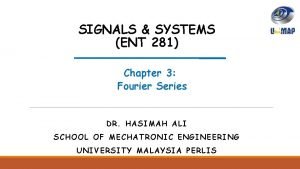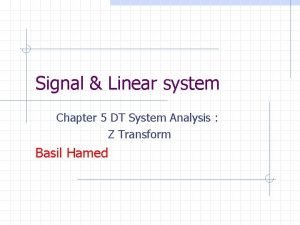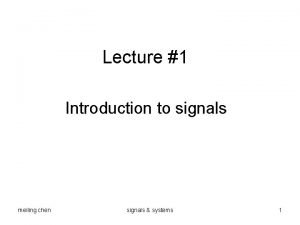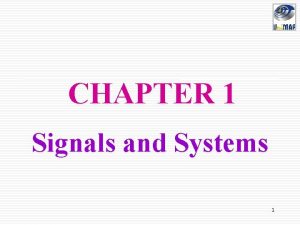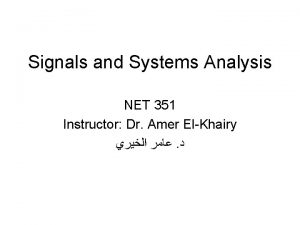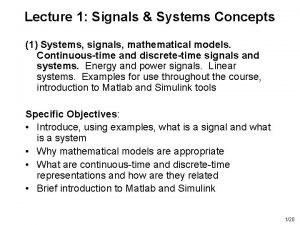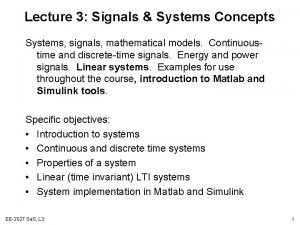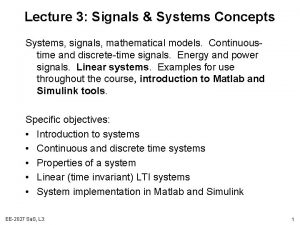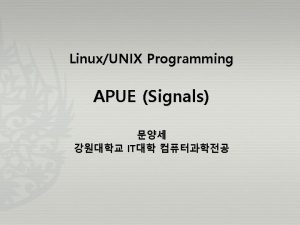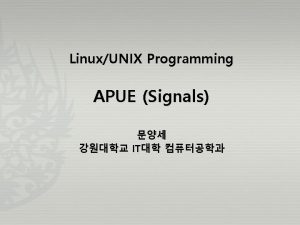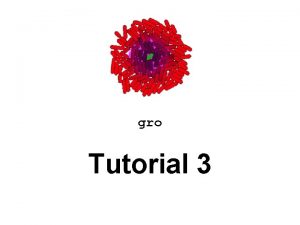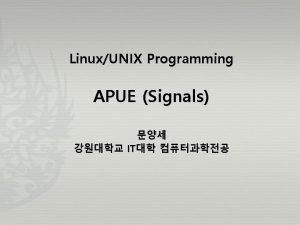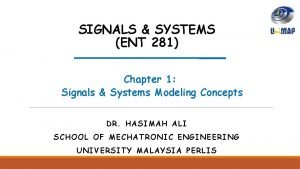Signals and Systems EEC 2730EEEC 2730 Lecture Notes









- Slides: 9

Signals and Systems EEC 2730/EEEC 2730 Lecture Notes - Signals and Systems

Syllabus UNIT I: Introduction To Signals And Systems Classification of signals, Basic operation on signals, Elementary signals, Representation and Classification of continuous and discrete time systems, Properties of systems, System Model: Input-Output Description. UNIT II: Time-domain Analysis Of Systems System representation through differential equations and difference equations, Impulse response and its properties for LTI systems, Convolution and its properties, Sampling and recovery of signals. Lecture Notes - Signals and Systems

UNIT III: Fourier Representation For Signals Review of Trigonometric Fourier Series, Exponential Fourier Series, Fourier Transform and its properties, Discrete-Time Fourier Transform (DTFT) and the Discrete Fourier Transform (DFT). UNIT IV: System Analysis Using Laplace Transform And Z-transform Laplace Transform and its properties, Inversion of Laplace Transform, Solving Differential Equations with Initial Conditions, Unilateral and Bilateral Z-Transform and its Properties, Region of Convergence, Inversion of Z-Transform analysis of LTI systems. Lecture Notes - Signals and Systems

Introduction • The signals are functions of one or more independent variables which contain information about the behaviour or nature of some phenomenon. • Systems respond to particular signals by producing other signals or some desired behaviour. • Examples – Voltage and Current in an electric circuit. • Voltage and Current – signals ; electric circuit – system (which responds to applied voltage and current). Lecture Notes - Signals and Systems

Examples: • An automobile system • A camera is a system that receives light from different sources and reflected from objects and produces a photograph. • A robot arm is a system whose movements are response to control inputs. Lecture Notes - Signals and Systems

Applications • In some cases, we are interested in characterising a specific system that how it will respond to various inputs. For example, the analysis of a circuit in order to know its response to different voltage and current. • In other problems, rather than analysing existing systems, our interest may be focused on designing systems to process signals in particular ways. For example to restore or enhance signals that have been degraded in some way. For example in area of image enhancement and image restoration. Lecture Notes - Signals and Systems

• Sometimes, there is a need to design systems to extract specific information from signals. For example, estimation of heart rate from ECG signal. • Another important application of signals and systems is to modify or control the characteristics of a given system, through the choice of specific input signals or by combining the system with other systems. • For example, design of control systems to regulate chemical processing plants. The control system in such a plant responds to variety of sensors signals (that measure physical signals such as temperature, humidity, chemical composition etc. ) by adjusting quantities such as flow rates and temperature in order to regulate the ongoing chemical processes. Lecture Notes - Signals and Systems

• In other applications, the focus may be on the design of signals with particular properties. • Example - In communications applications, there is a need to designals to meet the constraints and requirements for successful transmission. For example, long distance communication through the atmosphere requires the use of signals with frequencies in a particular part of electromagnetic spectrum. Lecture Notes - Signals and Systems

SUGGESTED READING / TEXTS / REFERENCES • A. V. Oppenheim, A. S. Wilsky and S. H. Nawab, Signals and Systems, Pearson Ed. • S. Haykin and B. V. Veen, Signals and Systems, John Wiley and Sons. • T K Rawat, Signals and Systems, Oxford University Press. • B P Lathi, Signal Processing and Linear Systems, Oxford University Press. Lecture Notes - Signals and Systems
 01:640:244 lecture notes - lecture 15: plat, idah, farad
01:640:244 lecture notes - lecture 15: plat, idah, farad Communicative signals and informative signals
Communicative signals and informative signals Informative signals example
Informative signals example Communicative and informative signals
Communicative and informative signals Advanced operating system notes
Advanced operating system notes Fourier series integral
Fourier series integral Signals and systems oppenheim solutions chapter 5
Signals and systems oppenheim solutions chapter 5 Precedence rule in signals and systems
Precedence rule in signals and systems Precedence rule in signals and systems
Precedence rule in signals and systems Convolution sum in signals and systems
Convolution sum in signals and systems





